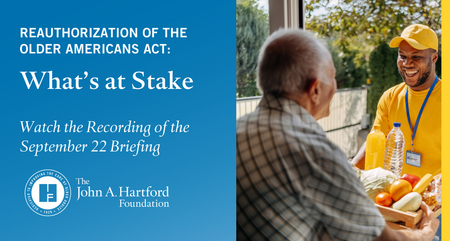Reauthorization of the Older Americans Act: What’s at Stake
Congress is debating the reauthorization of the Older Americans Act (OAA), with the Older Americans Act Reauthorization Act of 2025 (S.2120) introduced in the Senate on June 18, 2025, to authorize appropriations through FY2030. The OAA, which has been a vital part of America’s aging policy for the past 60 years, is due for reauthorization every four years. This year, structural changes under the Trump administration—such as the reorganization of the Department of Health and Human Services (HHS), the dissolution and redistribution of the Administration on Community Living (ACL), and overall staffing reductions and budget cuts across federal agencies—may affect the OAA’s reauthorization and the scope of programs included in the OAA.
On September 22, the John A. Hartford Foundation held a virtual briefing to explore the implications of reauthorizing the Older Americans Act and the policies that will shape senior care in the years ahead. This briefing, titled “Reauthorization of the Older Americans Act: What’s at Stake,” gathered experts, advocates, and policymakers to examine proposed changes, address concerns, and consider strategies to enhance services for older Americans.
Speakers included several CHaSCI partners:
Rani E. Snyder, MPA, Acting President at The John A. Hartford Foundation
Abby Cox, MSW, Senior Director of Aging Policy at ADvancing States
Amy Gotwals, Chief of Public Policy & External Affairs at USAging, and
Bob Blancato, President, Matz, Blancato & Associates; National Coordinator, Elder Justice Coalition; Executive Director, National Association of Nutrition and Aging Services Programs
Some key takeaways from the briefing include:
History and timeline of amendments to the OAA, starting with President Lyndon B. Johnson signing the Act into law in the summer of 1965 and tracking additions and amendments to the law all the way up until its most recent reauthorization by President Trump on March 23, 2020.
The scope and leverage of OAA funding. The Older Americans Act currently provides $2 billion in grants to trusted state and local organizations that offer meals, transportation, caregiver support, employment training and other services to one in six older adults nationwide.
Equity, flexibility, and future funding pressures. Panelists emphasized the need for formulas and policies that better address historically underserved populations (rural communities, tribal elders, low-income older adults), and the importance of providing states and service providers flexibility to innovate.
Potential legislative changes worth watching. Proposals include greater investment in the Long-Term Care Ombudsman Program, easier access for family caregivers, stronger elder-abuse prevention measures, and updated training standards.
Advocacy as a critical lever. The success of reauthorization efforts will depend in part on sustained engagement from aging networks, service providers, and individuals who can tell their stories and push for changes on Capitol Hill.
Over the course of the webinar, speakers unpacked how updates to funding, eligibility, and program oversight could affect key systems such as nutrition programs, long-term care services, and community supports. They also took questions from the audience, bringing in real-world perspectives from older adults, caregivers, and service providers. The discussion highlighted both the potential benefits and the risks of different policy pathways—emphasizing equity, sustainability, and the urgent needs of underrepresented older populations.
Speakers urged the audience to take action in the following ways:
Share insights with your network. Forward highlights, graphics, or data to local aging-service organizations, policymakers, or community groups.
Reach out to your U.S. Senators and Representatives. Urge them to support strong reauthorization legislation that reflects equity, sustainability, and innovation.
Stay engaged. Sign up for updates from organizations such as The John A. Hartford Foundation, USAging, and ADvancing States to receive policy alerts and advocacy toolkits.
If you couldn’t attend live, you can access the full recording, slides, and additional resources here.
Whether you work in aging services, represent an advocacy group, or simply care about the well-being of older Americans, this briefing offers valuable insights into what’s at stake with the next round of legislation—and how stakeholders can engage in shaping its outcome.

